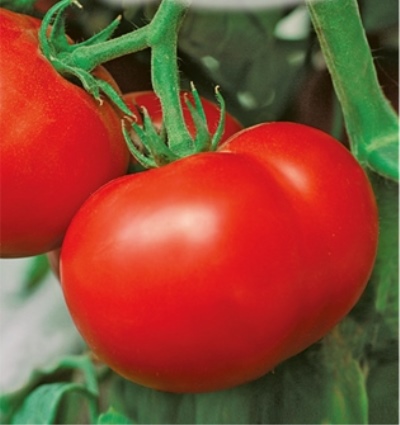
- Category: hybrid
- Growth type: indeterminate
- Appointment: fresh consumption
- Ripening period: mid-season
- Ripening time, days: 94-115
- Growing conditions: for greenhouses
- Transportability: Yes
- Marketable fruit yield,%: 95-97%
- Bush characteristic: compact
- Unripe fruit color: green
The hybrid tomato attracts gardeners with its charming appearance, thanks to which the Stresa variety is often grown for sale. Ordinary gardeners note the excellent yield of fruit crops and strong immunity, which protects plants from harmful insects, diseases and infections.
Description of the variety
Breeders bred a tomato with an indeterminate type of growth. The bushes are recommended to be cultivated in greenhouses or hotbeds, and the harvested fruits are enjoyed fresh. The bushes are neat and compact, they do not take up much space on the site. The color of shoots and leaves is rich green.
Plants reach 1.7 meters in height and are considered tall. Up to 6 tomatoes grow and ripen in one brush at the same time. The Stresa variety was bred in Russia specifically for growing indoors, but in regions with warm and temperate climates, it is possible to lay open beds. The first brush appears over 8 or 9 leaves, and the rest occurs every 2-3 leaves.
The main qualities of the fruit
Initially, the fruits are colored green, which eventually changes to a bright red. Weight varies from 160 to 200 grams on average, larger specimens are also found. The surface of the vegetables is covered with medium-sized ribs, the shape is flat-round. All fruits are the same size. The skin is smooth and glossy, with a characteristic shine. The pulp is firm.
Ripe fruits are often used in salads, dressings, juice, or preservation. A small number of seeds are formed inside. The color of the flesh is as bright as the color of the skin. The amount of water in the fruit is minimal.
Taste characteristics
The taste is slightly sour, but pleasant. Most gardeners speak positively about the taste of vegetables.
Ripening and fruiting
The variety is considered mid-season. The ripening period ranges from 94 to 115 days.
Yield
High yield is a characteristic feature of the Stresa tomato. About 25 kilograms of tomatoes are harvested from one square meter of land. The crop is highly transportable. The yield of marketable fruits is high and amounts to 95-97%. The harvested crop can be stored for a long time and tolerates long transportation.
The timing of planting seedlings and planting in the ground
When growing seedlings, seeds are sown in the second half of March. Depending on the climate, planting can be carried out at the end of March or early April. Seed material is germinated in garden soil, which is mixed with humus or peat. Superphosphate or wood ash is added to it. The earth is treated with hot solutions of 1% manganese or kept in an oven to kill harmful bacteria. The mixture is watered and left for several days for the development of fruitful microflora.
The collected seeds are also processed using liquid fertilizers or growth stimulants. The grains are placed in the grooves, after which they moisten the ground, and the containers with future seedlings are covered with a film. They are kept in a room with a temperature of about 23 degrees Celsius. Seedlings are planted after the formation of two leaves. The bushes are transplanted into greenhouses around mid-May. When transferred to open ground, work is carried out later.

Growing tomato seedlings is an extremely important process, because it largely depends on whether the gardener will be able to harvest at all. All aspects must be taken into account, from seedbed preparation to planting in the ground.
Landing scheme
Tomatoes are planted according to the scheme 70x40 centimeters.

Growing and care
During the cultivation of tomatoes, the bushes are stepson, removing unnecessary lateral processes. So the fruits will be as large and juicy as possible. Bushes are formed into one stem. This option is considered optimal for regular fruiting. About a month before the end of the harvest season, pinch the growth point.
All tall plants need a garter. The stops are set in advance. Some gardeners prepare them even before the transfer of seedlings. Tie up the branches carefully so as not to harm them. For fixation, pieces of tissue are used that do not injure the plant.
Vegetable culture Stresa is very rarely sick. The bushes are practically not affected by tobacco mosaic, fusarium and other diseases that are common among nightshades. However, it is not recommended to abandon standard preventive measures. In order to avoid infection, it is necessary to maintain a low level of air humidity in the greenhouse; for this, the room is regularly ventilated.
Regular loosening is good for the condition of the bushes. The roots become stronger and develop better. It is also helpful to cover the ground around the plants with a layer of organic straw or peat mulch.
If dangerous insects start in the ground, they are fought with using chemical compounds. Instead of ready-made preparations, you can choose folk remedies, for example, a decoction of onion peels. Many people use a decoction of chamomile or celandine. A weak solution of potassium permanganate will also be helpful.
The Stresa variety is considered unpretentious in care and is great for beginners who are just beginning to gain experience in growing tomatoes. It is enough just to regularly water the plants, take care of the land and carry out simple preventive actions.




A plant needs different micronutrients at each stage of growth. All fertilizers can be divided into two groups: mineral and organic.Folk remedies are often used: iodine, yeast, bird droppings, eggshells.
It is important to observe the rate and period of feeding. This also applies to folk remedies and organic fertilizers.



























































































